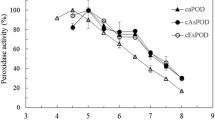Abstract
A number of plants were tested for their ability to bind ethylene and the number of binding sites present in each was calculated. Primary leaves of laboratory-grown beans (Phaseolus vulgaris) bound 140 dpm/g fwt (1794 dpm/g dry wt) when exposed to 1.0 μCi/1 of [14C]ethylene (110 ci/mol). Phytotron-grown leaves were less succulent but only bound 90 dpm/g fwt (1046 dpm/g dry wt). Bean roots bound 30 dpm/g fwt. Citrus and Ligustrum bound 207 and 240 dpm/g fwt, respectively. The time required to achieve equilibrium of leaves with the gas phase was 15 min for bean, 30 min for Citrus, and 30–60 min for Ligustrum. The time for 1/2 of the bound ethylene to diffuse out of the leaves was 20 min for bean, 10 min for Citrus, and 30 min for Ligustrum. The amount of ethylene needed to occupy 1/2 of the binding sites was obtained from Scatchard plots. This value (Kd) was 0.2 μl/1 for bean, 0.15 for Citrus, and 0.31 for Ligustrum. The quantity of binding sites in the tissues was 2.0×10-9 mol of binding sites/kg tissue for bean leaves, 5.7×10-9 for Citrus leaves, and 6.8×10-9 for Ligustrum. Pretreatment with indoleacetic acid (IAA), ehtylene, and cycloheximide (1 mg/1) had little effect on the level of ethylene-binding sites in Citrus.
Similar content being viewed by others
References
Abeles FB (1973) Ethylene in plant biology. New York: Academic Press
Adams DO and Yang SF (1981) Ethylene the gaseous plant hormone: Mechanism and regulation of biosynthesis. Trends Biochem Sci 6: 161–164
Bengochea T, Acaster MA, Dodds JH, Evans DE, Jerie PH and Hall MA (1980) Studies on ethylene binding by cell-free preparations from cotyledons of Phaseolus vulgaris L. II. Effects of structural analogs of ehtylene and of inhibitors. Planta 148: 407–411
Bengochea T, Dodds JH, Evans DE, Jerie PH, Niepel B, Shaari AR and Hall MA (1980) Studies on ethylene binding by cell-free preparations from cotyledons of Phaseolus vulgaris L. I. Separation and characterization. Planta 148: 397–406
Beyer EMJr (1975) 14C2H4: Its incorporation and metabolism by pea seedlings under asptic conditions. Plant Physiol 56: 273–278
Beyer EMJr (1979) Effect of silver ion, carbon dioxide and oxygen on ethylene action and metabolism. Plant Physiol 63: 169–173
Dodds JH and Hall MA (1980) Plant hormone receptors. Sci Prog Oxford 66: 513–535
Evans DE, Bengochea T, Carns AJ, Dodds JH and Hall MA (1982) Stuides on ethylene binding by cell-free preparations from cotyledons of Phaseolus vulgaris L. Subcellular localization. Plant Cell Environ 5: 101–107
Goren R and Sisler EC (1982) Ethylene-binding characteristics of some plants. Plant Physiol 69: S138
Ismail MA (1969) Variationin the abscission response of aging citrus fruit and leaf explants to ethylene and 2,4-D. J Amer Soc Hort Sci 95: 319–322
Jerie PH, Shaari AR and Hall MA (1979) The compartmentation of ethylene in developing cotyledons of Phaseolus vulgaris L. Planta 144: 503–507
Lowry OH, Rosebrough NJ, Farr AL and Randall RJ (1951) Protein measurement with the Folin phenol reagent. J Biol Chem 193: 265–275
Riov J (1971) Polygalacturonase for citrus leaf explants. Plant Physiol 53: 312–316
Scatchard G (1949) The attraction of proteins for small molecules and ions. NY Acad Sci 51: 660–672
Sisler EC (1977) Ethylene activity of some π-acceptor compounds. Tobacco Sci 21: 43–45
Sisler EC (1979) Measurement of ehtylene binding in plant tissue. Plant Physiol 64: 538–542
Sisler EC (1980) Partial purification of an ethylene-binding component from plant tissue. Plant Physiol 66: 404–406
Sisler EC (1982) Ethylene binding in normal, rin and nor mutant tomatoes. J Plant Growth Regul 1: 219–226
Trewavas AJ and Jones AM (1981) Consequences of hormone binding studies for plant growth substance research. What's New in Plant Physiol 12: 5–8
Warner HL (1970) The synthesis and mode of action of ethylene in etiolated pea seedlings. Ph.D. Thesis, Purdue Univ. Lafayette, Indiana
Author information
Authors and Affiliations
Additional information
Contribution from the Department of Biochemistry, School of Agriculture and Life Sciences and School of Physical and Mathematical Sciences, North Carolina State University. Paper No. 8445 of the Journal Series of the North Carolina Agricultural Research Service, Raleigh, North Carolina 27695-7601.
North Carolina-Israel exchange Scholar for 1981 at the Department of Biochemistry, North Carolina State University Raleigh, North Carolina, USA
Rights and permissions
About this article
Cite this article
Goren, R., Sisler, E.C. Ethylene-binding characteristics in Phaseolus, Citrus, and Ligustrum plants. Plant Growth Regul 4, 43–54 (1986). https://doi.org/10.1007/BF00025348
Received:
Revised:
Accepted:
Issue Date:
DOI: https://doi.org/10.1007/BF00025348




